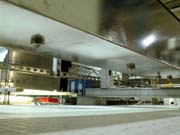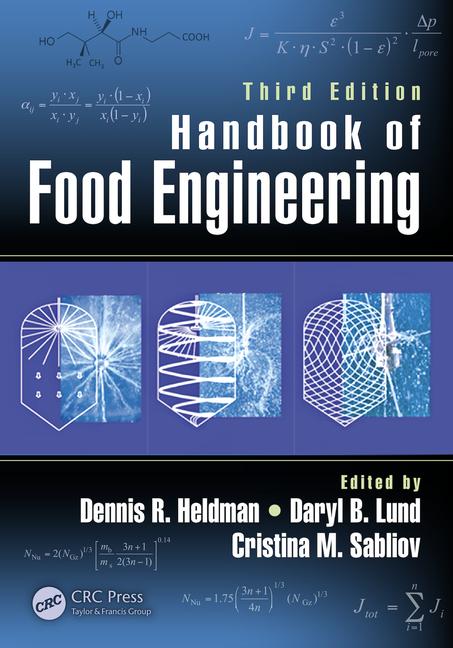
The development project is a partnership between GTRI and BOC Thinkage. Research engineers and technology managers are pooling their expertise to build the system and verify results to the satisfaction of USDA and other regulators. Heading the project is John Stewart, a GTRI research engineer with extensive experience in systems integration and computer modeling and simulation. A graduate of Davidson College with a degree in physics, Stewart received a Master’s in electrical engineering from Georgia Tech. He has done heat-transfer modeling for GTRI’s thermal signature modeling program, including infrared modeling for the Department of Defense. Food Engineering spoke with Stewart as he and his team were assembling a prototype unit for preliminary testing in a commercial plant.
FE: What are the technical elements of the system for non-contact core temperature analysis?
Stewart: Two technologies will be used to calculate the core temperature of the largest pieces coming out of the oven: a 3-D stereo camera for the imaging system, and infrared (IR) sensors. Models that calculate core temperature based on surface temperature measurements over time will be verified by laboratory and in-plant measurements. If there is more than a two degree difference in the calculations by the camera and IR system, an alarm sounds to alert operators that there might be a problem
FE: How do processors currently monitor core temperature?
Stewart: You might find a couple of operators sticking thermocouple probes into the larger pieces as they emerge from the oven, then manually recording the temperature and stopping the line if the temperature is too low. The next step up would be a probe that is hooked up to a computer, with data being graphed for review by supervisory personnel.
Probes are accurate to within a degree Fahrenheit, but the whole technique is a bit of an art form. A lot of things can go wrong. Are operators probing the biggest pieces? Do they know where the maximum core temperature was reached? The core may still be heating up after the piece emerges from the oven. Is the probe stuck in the right place?
It’s a boring, repetitive job, prone to human error. Plus, the probe itself is a potential instrument for cross contamination.
FE: How did this project come about?
Stewart: BOC Thinkage had some sensors on a partially cooked frying line, which was useful in detecting general trends in par cooking. Demonstrating to regulators that sensor technology could ensure consistency in fully cooked poultry was not something BOC could take on by themselves, however, so they contacted us.

Stewart: BOC devised a blind system, without any 3-D imaging capability and relying on four temperature sensors. It worked fairly well, but without 3-D imagery and an understanding of the shapes it was sensing, it could only provide general trending information, not data on the core temperature of the most difficult pieces to cook. It also worked on a line that produced the same product, day after day.
Our goal is to determine the absolute core temperature, and to do it despite variability in a number of day-to-day factors. We also want to devise a system that can handle diverse products. That means operators must be able to rapidly and easily reconfigure the system. It should also address visual inspection issues, such as the degree of browning specified by the customer, or the presence of braise marks in individual pieces. These are product specs that are often overlooked now because the operators are so busy manually probing pieces that they overlook them.
FE: How do imaging systems and IR sensors determine core temperature?
Stewart: Several temperature measurements of an object are taken, separated in time. When a chicken piece exits the oven, it enters into a relatively cool zone, and the rate of cooling will be different if the core of the product is hot than if it is frozen. The system will compare a series of images and determine the maximum temperature reached in the core.
A major component is the 3-D imaging module, possibly an adaptation of the 3-D stereo camera that our Agricultural Technology Research Program has been testing for automated cutting applications.
The prototype system will include a laser designator to identify the pieces to be monitored. It is specific to the test and won’t be part of the final design. It’s critical at this stage, however, to ensure that the line operators are measuring the same pieces that the system is measuring. This will help us build a verified database of temperature readings for the thermal heat transfer model
FE: What kind of IR sensors will you use?
Stewart: Most likely infrared radiometer sensors, which are relatively simple devices that are accurate and repeatable to 1˚C for three to 10 samples per second. Four of them would be wired into a circuitry box. They cost about $500 each. Alternatively, a single IR camera could cover the entire conveyor belt and collect a lot more measurements using microbolometer technology, and there is only one part that can fail.
FE: What are microbolometers?
Stewart: Microbolometers are tiny thermometers, each arrayed with a pixel in the final IR image. They respond very quickly to temperature changes and produce high-resolution images without cryogenic cooling. It’s inexpensive technology and was deployed earlier this year by Indigo Systems Corp. to scan passengers at airports in China. These hand-held imaging devices were used to detect passengers with elevated temperatures that might be an indication of SARS-related fever. Passengers with a body temperature of 37.5˚C or above were then directed to medical personnel for testing, isolation and possible treatment.
Almost 30 companies are building hundreds of thousands of these cameras, with much of that production driven by homeland security and the defense department’s goal of disposable IR cameras costing about $1,000 each that can be deployed everywhere. Indigo’s Omega camera already is priced under $10,000, though it costs more for a camera with accurate temperature calibration. We are testing a Mikron camera that is accurate to 2 percent or 2˚C.
FE: How affordable is a non-contact core-temperature monitoring system likely to be?
Stewart: System cost is a giant consideration. That’s one of the reasons BOC Thinkage is working with us. They have to be able to demonstrate to processors that a core temperature monitoring system is safe, reliable, and can be built for a price that is affordable.
FE: What are the challenges in system design?
Stewart: The system won’t be particularly big, but space is always an issue in a plant. We have to package a system than can run in a number of plants without getting in people’s way. Cooked chicken typically is conveyed quickly from the oven to the cooler. We need 10 to 20 seconds on the belt, depending on the specific product, to get an accurate reading of core temperature.
System design has to be rock solid. It needs to be kept cool, even though it’s next to an oven, and the LED lighting for the imaging system has to use as little power as possible. Low maintenance and sanitary design are other prerequisites. We’re relying on BOC’s expertise in the plant operating environment to help us.
FE: What are the obstacles to commercialization?
Stewart: Building the prototype is the first stage, and that should go smoothly. There may be some minor crises with the core-temperature modeling, but we’ll overcome them.
Dealing with regulators is unchartered water for me. That’s where we’ll see the most twists and turns. The ultimate goal is acceptance of the system for HACCP inspection. We’re relying on our commercial partners’ experience to help us. I think we’ll be able to produce a viable commercial system in two to three years.


